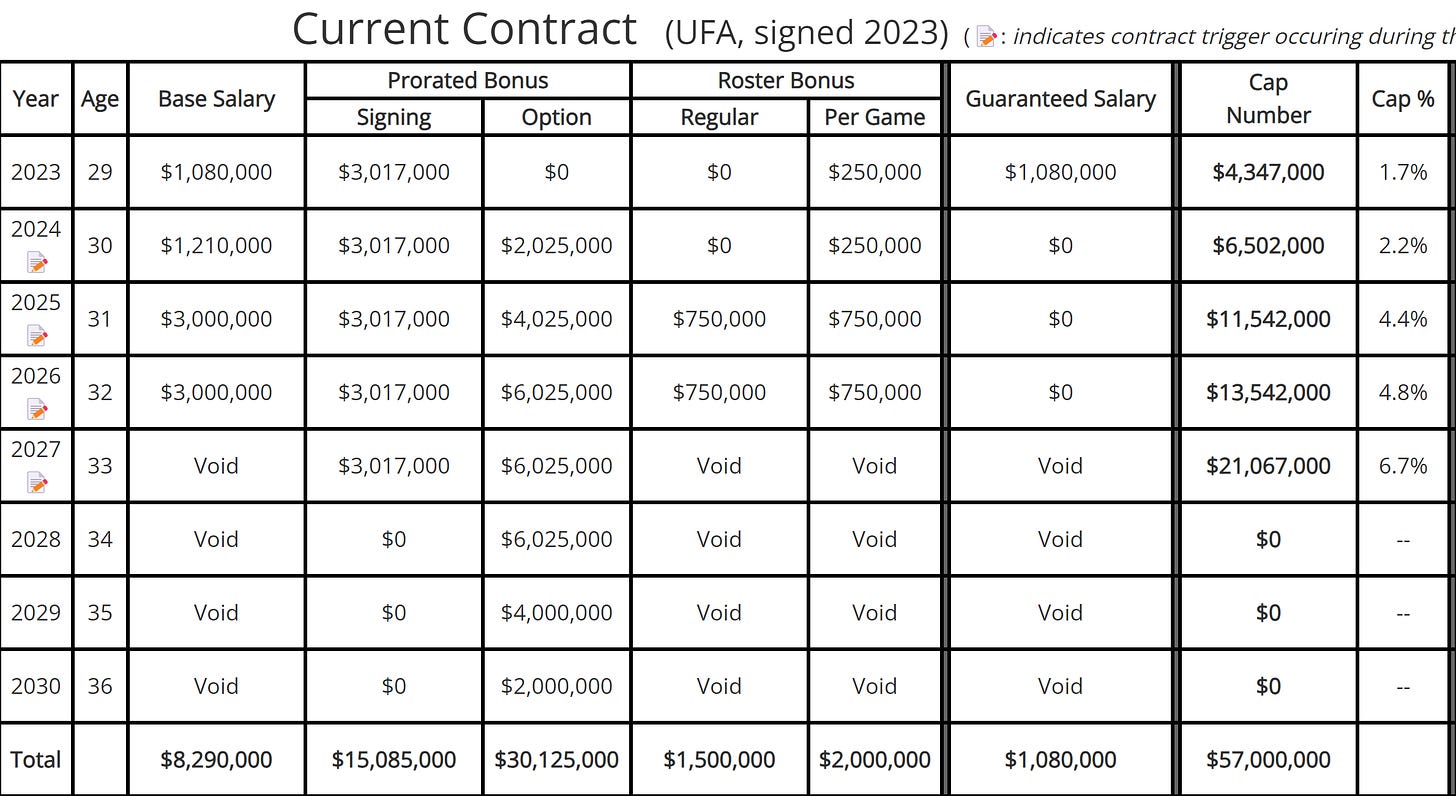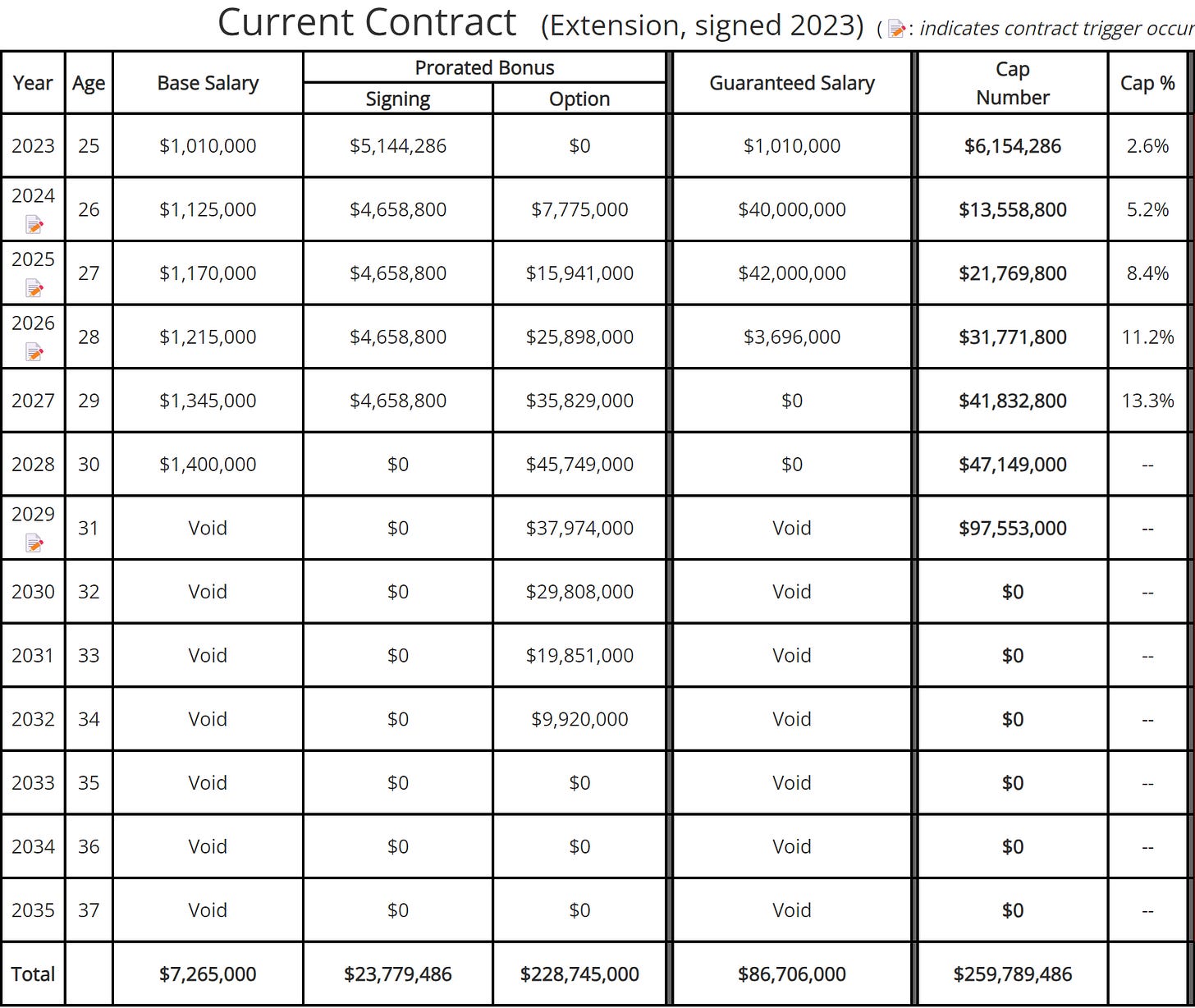The Newest Method of Salary Cap Circumvention
The best NFL front offices have been adept at finding innovative means to take advantage of the salary cap system. I analyze the latest way -- option bonuses.
AUTHOR’S NOTE: Links to supplementary materials describing various salary cap concepts are located at the end of this article.
The core concept of economics is reckoning with scarcity — finding the balance between unlimited wants and limited resources. In the NFL, the desire of a team’s from office to build the best roster possible is capped by a set of constraints, whether it’s roster size, draft capital, or the salary cap. At the most basic level, each NFL player’s contract takes up a percentage of the team’s salary cap, with a “cap number” comprised of various components of a player’s salary in a given year. For as long as the salary cap has been in existence, NFL teams have found several ways to manipulate the cap and lower players’ cap hits without decreasing their salaries: restructures, void years, and most recently — option bonuses.
What Are Option Bonuses?
An option bonus basically acts a combination of a roster bonus and a contract restructure. In its assigned year, a team has the “option” to exercise the option bonus by prorating it over the maximum of five years like with a signing bonus, or they can incur the full cap hit of the option. To better illustrate, here is the contract of Cleveland Browns’ iDL Dalvin Tomlinson, who signed in 2023, as shown on OvertheCap (OTC):

Tomlinson’s contract contains three option bonuses: a 2024 option bonus worth $10.125M, a 2025 option bonus worth $10M, and a 2026 option bonus worth $10M. The contract page on OTC assumes all three option bonuses will be exercised in the following manner:
If the option bonuses are exercised, prorated money from each option bonus counts against the cap every year, which is why Tomlinson will have $4.025M of his cap hit coming from option bonuses in 2025 ($2.025M of the 2024 bonus + $2M of the 2025 bonus) and $6.025M in 2026 ($2.025M of the 2024 bonus + $2M of the 2025 bonus + $2M of the 2026 bonus).
If the option bonuses were to be declined, the full amount of the option bonus would become a part of the player’s salary cap number for that year like so:
Why NFL Teams Would Use Option Bonuses
It depends on the specific contract of course, but by exercising an option bonus, teams could significantly lower a player’s cap hits throughout the life of the entire contract. Going back to Tomlinson as an example, Tomlinson signed a four year, $57M at face value, with a $14.25M average per year that was worth 6.3% of the 2023 salary cap ($224.8M). When looking at Tomlinson’s contract on OTC, however, if all of the option bonuses are exercised, his cap hit will never exceed 6.3% of OTC’s projected salary cap in any non-void year. For a team like the Browns that is stuck with Deshaun Watson having a cap hit of over $63M for the next three years, option bonuses make a lot of sense as a way to spread a large amount of salary cap space into the future, which is why it should be no surprise that the Browns lead the NFL in the number of contracts with an option bonus.
Why NFL Teams Would Not Use Option Bonuses
While option bonuses allow for more roster-building flexibility throughout the duration of the contract, pushing such a large amount of salary into the future will result in an exorbitant amount of dead cap when the bill eventually comes due. For example, when the Eagles signed Jalen Hurts to a 5 year, $255M contract extension in 2023, $228M-ish of that money was in the form of option bonuses. If all of the option bonuses are exercised throughout the contract, the Eagles would have a dead cap charge of ~$97M if he’s not extended before his contract voids (for now):

In addition, because option bonuses push out a significant amount of cap space into the future, it becomes functionally impossible to release a player with an option bonus in the middle of their contract. Going back to Tomlinson, if in 2025 the Browns were to release Tomlinson for some reason before June 1st, they would be on the hook for $17.151M in dead cap (assuming no other guaranteed salary) and they would actually lose cap space in Year 3 of a four year contract, which is unusual compared to most contracts that don’t have option bonuses.
In fact, Russell Wilson is the only recent example of a player that was cut with an option bonus, though the Broncos decided to decline the bonus and take on the full option bonus as part of their cap total this year.
Conclusion
In terms of functionality, an option bonus doesn’t behave differently than a typical contract restructure in the sense that, if a team converts a player’s base salary or roster bonus into a signing bonus, the money prorates over the life of the contract just like an option bonus does if exercised. It is interesting, however, that option bonuses are starting to become more common as of late. Here is an approximate list of players who have option bonuses in their current contracts:
Of these 65 players, 52 were signed in 2022 or later (80%), and 36 were signed in 2023 or later (55.4%).
Due to the limited sample size, and the fact that the full impact of a majority of option bonuses on teams’ future salary cap flexibility won’t be realized until much later, it’s too early to tell whether they will still be used more often. In the meantime, as teams are using option bonuses at an increasing rate — most notably the Browns, Ravens, and Eagles — the short-term impact is still worth monitoring.
Supplementary Materials:
Basic salary cap guide: https://overthecap.com/a-guide-to-the-nfl-salary-cap
How restructures work: https://overthecap.com/restructure
How void years work: https://overthecap.com/examining-the-pros-and-cons-of-void-years-for-salary-cap-relief
How roster bonuses work: https://overthecap.com/use-roster-bonus-free-agency







